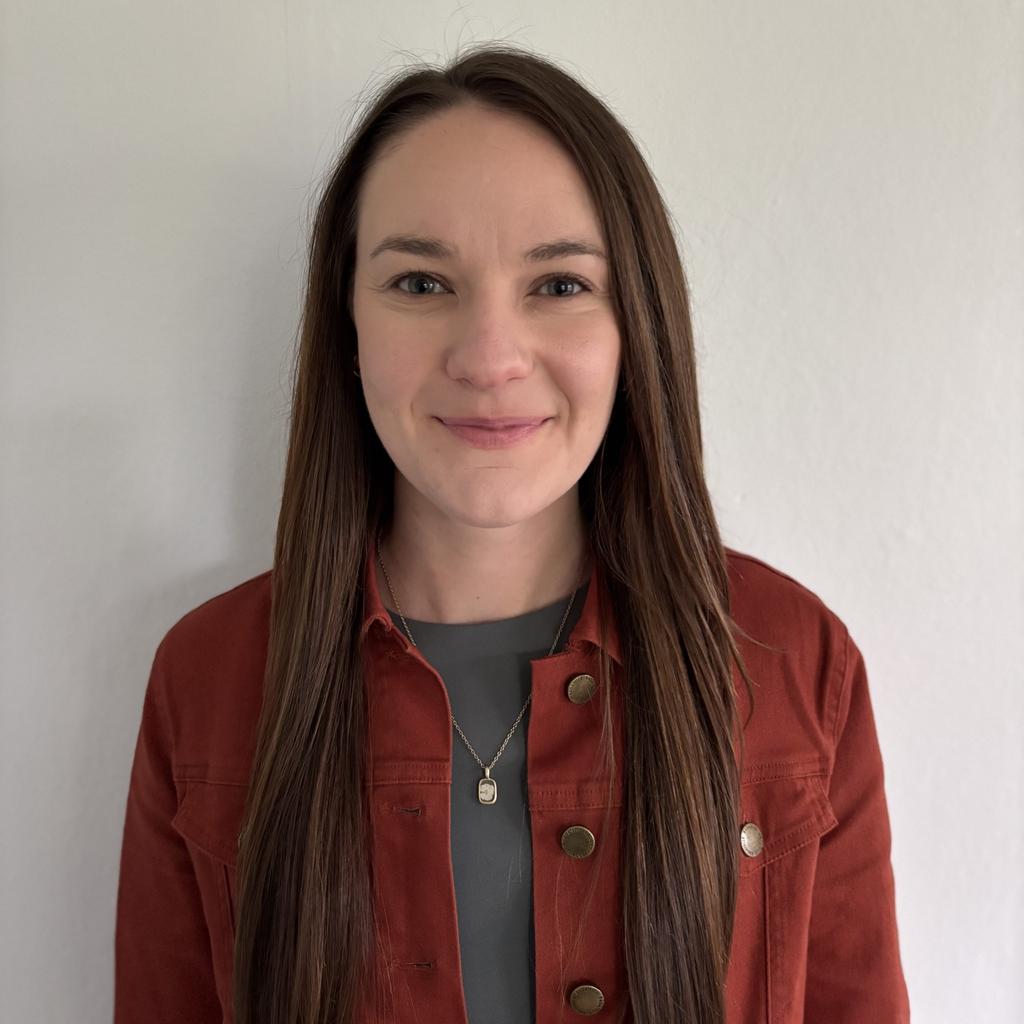Why this resume works
- Quantifies accomplishments: By pulling actual metrics from their roles, such as a 35% reduction in computation time, the applicant’s impact is evident.
- Showcases career progression: Starting as a data analyst and advancing to business analyst before joining an AI research lab, the applicant shows notable career progression and increased responsibilities over time.
- Highlights industry-specific skills: The applicant’s experience with machine learning and big data technologies underlines their industry-specific skills essential for tech-driven roles.
More Graduate Resume Examples
Review these graduate resume examples to see how to showcase your academic achievements, internships, and relevant projects. Use these samples to provide a solid base for creating a resume that stands out in entry-level job applications.
Graduate trainee
Why this resume works
- Centers on academic background: The applicant’s academic background is presented at the top, showing employer’s that they are well trained right off the bat.
- Shows digital literacy: By mastering tools like Python and machine learning, the applicant showcases strong computer skills important for roles in computer science.
- Effective use of keywords: Using strategic keywords such as “data analysis” and “statistical modeling,” the resume improves its visibility in ATS systems.
Entry-level coordinator
Why this resume works
- Includes a mix of soft and hard skills: By mixing technical prowess in process improvement with interpersonal skills, the applicant effectively coordinates projects and fosters team collaboration across departments.
- Demonstrates language abilities: The applicant’s language skills in Spanish, French, and German improve their ability to manage diverse teams and facilitate international communication effortlessly.
- Points to measurable outcomes: Achieving a 20% increase in team efficiency and reducing expenses by 10%, the applicant showcases concrete results that highlight their strategic impact and organizational contributions.
Junior associate
Why this resume works
- Lists relevant certifications: Listing certifications like Certified Project Manager and Scrum Master reinforces the applicant’s expertise in project management and commitment to continuous learning.
- Showcases impressive accomplishments: Winning “Employee of the Year” and leading a software development team highlight effective accomplishments, showcasing strong leadership and contribution to business success.
- Sections are well-organized: Clear headers and concise bullet points create a well-organized layout, making it easy for readers to quickly scan through the applicant’s extensive work experience.
Graduate Resume Template (Text Version)
Min Zhang
Oakridge, OR 97467
(555)555-5555
Min.Zhang@example.com
Professional Summary
Data-driven graduate skilled in analytics, machine learning, and cloud-based technologies, with proven success optimizing workflows and leveraging insights to deliver impactful results.
Work History
Graduate
AI Research Lab – Oakridge, OR
August 2023 – August 2025
- Analyzed 120+ datasets to improve system models
- Optimized algorithms reducing computation time by 35%
- Designed workflows improving task automation by 40%
Business Analyst
TechSolutions Inc. – Portland, OR
August 2019 – July 2023
- Developed dashboards increasing insights access by 50%
- Facilitated $1M annual cost savings via data-driven findings
- Proposed strategies boosting team efficiency by 28%
Data Analyst
Insight Analytics Group – Portland, OR
August 2017 – July 2019
- Interpreted 300+ data logs enhancing accuracy by 20%
- Streamlined metrics tracking reducing errors by 30%
- Presented findings increasing client retention by 15%
Skills
- Data Analytics
- Machine Learning
- Statistical Analysis
- Python Programming
- SQL Queries
- Big Data Technologies
- Predictive Modeling
- Cloud-Based Solutions
Education
Master of Science Data Science
University of Texas at Austin Austin, Texas
May 2017
Bachelor of Science Computer Science
Texas A&M University College Station, Texas
May 2015
Certifications
- Certified Data Analyst – Data Science Council of America
- Machine Learning Specialist – Global AI Institute
Languages
- Spanish – Beginner (A1)
- French – Intermediate (B1)
- German – Beginner (A1)
Related Resume Guides
Advice for Writing Your Graduate Resume
Learning how to write a resume tailored to your profession can make all the difference in landing the job you’re after. Whether you’re aiming for an engineering role or diving into marketing, discover how to spotlight your unique skills and experiences in a way that grabs attention.
Highlight your most relevant skills
Listing relevant skills on your resume is important when applying for a job as a graduate. It helps employers see at a glance what you can do and how you fit the role. A dedicated skills section makes it easy to show off both technical skills, like computer programming or data analysis, and soft skills, such as communication or teamwork. Balancing these skills paints a complete picture of your abilities.
It’s also smart to weave these key skills into your work experience section to give real examples of how you’ve used them in past jobs or projects. For instance, if you list problem-solving as a skill, mention a time when you solved a tricky issue at an internship or part-time job. This approach not only highlights your skills but also shows employers proof of how you’ve applied them effectively.
Overall, focusing on the right mix of skills ensures that you’re presenting yourself as well-rounded and ready for the job market. As a graduate, showing you have both the knowledge and the soft skills needed in today’s workplace can make all the difference in getting noticed by potential employers.
Select a resume format that highlights your education, skills, and any internships to show your readiness for the job.
Showcase your accomplishments
When you’re a graduate putting together your resume, it’s important to showcase any work experience you have in reverse-chronological order. Start with your most recent job and work backward. For each job, list the job title, employer name, location, dates you worked there, and your main duties.
But don’t just stop at listing duties; turn those duties into achievements by adding measurable results. This means instead of saying “responsible for managing social media,” say something like “increased social media engagement by 30% over six months.”
Quantifying your accomplishments makes your resume more compelling because it shows real impact. Use numbers whenever it makes sense. Did you save time or money? Improve a process? Think about percentages, cost savings, or efficiency improvements that highlight your contributions.
By quantifying your accomplishments, hiring managers can quickly see the value and skills you bring to the table. It gives them a clear picture of how you’ve made a difference in previous roles and suggests you’ll do the same in theirs. This approach will set you apart as a graduate ready to make an impact in any workplace.
5 graduate work history bullet point examples
- Managed a project team of 10, delivering a software application that increased client engagement by 25%.
- Conducted market analysis and identified key trends, leading to a 15% growth in product sales.
- Developed automated testing scripts for quality assurance, reducing testing time by 40%.
- Coordinated logistics for international shipments, improving delivery efficiency by 30%.
- Streamlined data entry processes using new software tools, cutting data processing time by 50%.
Choose a resume template that is clear and professional. Incorporate bold headings and simple fonts while avoiding flashy designs or excessive colors to highlight your skills and experience effectively.
Write a strong professional summary
A professional summary and a resume objective on a resume serve as introductions to hiring managers, offering a quick glimpse into who you are professionally. To start, decide between writing a summary or an objective depending on whether you have relevant experience in your field or not.
Typically three to four sentences long, a professional summary showcases your experience, skills, and achievements. It’s best suited for experienced applicants as it highlights their professional identity and value. The goal is to quickly convey what makes you stand out in your field.
In contrast, a resume objective states your career goals and works well for entry-level individuals, career changers, or those with gaps in their work history. The main difference is that summaries focus on “what I’ve accomplished,” while objectives focus on “what I aim to contribute.”
Next, let’s review examples of both summaries and objectives tailored to different industries and levels of experience to guide you in crafting your own strong first impression.
Graduate resume summary examples
Entry-level
Recent Bachelor of Science in Computer Science graduate with foundational skills in programming languages such as Java and Python. Completed an internship focused on software development and data analysis. Certified in AWS Cloud Practitioner, eager to contribute to innovative tech solutions and collaborate within dynamic teams.
Mid-career
Experienced marketing analyst with over six years in the consumer goods industry, specializing in market research and trend analysis. Successfully led a team to develop data-driven strategies that increased brand awareness by 30%. Holds a master’s degree in business analytics and known for strong problem-solving abilities and strategic thinking.
Experienced
Seasoned project manager with expertise in leading cross-functional teams in the technology sector. PMP certified with a track record of delivering complex projects on time and within budget. Proven leadership skills demonstrated through mentoring junior team members and driving process improvements that improved productivity by 25%.
Graduate resume objective examples
Recent graduate
Ambitious recent Bachelor of Science in Computer Science graduate seeking an entry-level software developer role to apply coding and problem-solving skills in a fast-paced tech company. Committed to contributing innovative ideas and solutions while growing as a professional in the field.
Career changer
Driven marketing professional transitioning into data analysis, with strong analytical skills and experience in interpreting trends gained through coursework and industry projects. Eager to leverage business acumen and analytical abilities to support data-driven decision-making in a collaborative environment.
Specialized training
Certified project management graduate with specialized training in agile methodologies seeking to join a dynamic team as a junior project manager. Passionate about using organizational and leadership skills to drive successful project outcomes and improve team productivity.
Stand out from the crowd by using our Resume Builder. Choose a design, fill in your details, and have a top-notch resume ready to go quickly!
Match your resume to the job description
Tailoring your resume to the job description is essential because it helps you stand out to employers and pass through applicant tracking systems (ATS). These systems scan resumes for specific keywords and phrases from job postings, making it important for applicants to include relevant terms.
An ATS-friendly resume includes keywords and phrases that match one’s skills with those listed in the job description. By customizing your resume, you increase your chances of catching the attention of hiring managers. It’s not just about listing qualifications; it’s about speaking the same language as the employer.
To identify key terms from job postings, look for skills, qualifications, and duties mentioned repeatedly. For example, if a posting for a nursing job frequently mentions “patient care,” “clinical assessments,” or “healthcare team collaboration,” these are significant terms to include in your resume.
Incorporate these terms naturally into your resume content. Instead of saying “Provide high-quality patient care,” you could write “Delivered high-quality patient care to improve overall health outcomes.” This method shows you understand the role’s requirements and have relevant experience.
Targeted resumes greatly improve ATS compatibility, ensuring your application passes initial screenings and reaches human eyes. Customizing your resume for each job makes you a stronger applicant and raises your chances of landing an interview.
Boost your resume’s odds of getting noticed by using our ATS Resume Checker, which scores your resumes performance and offers instant tips to help you get a better score.
FAQ
Do I need to include a cover letter with my graduate resume?
Yes, including a cover letter with your graduate resume can make a significant difference in your job application process.
A cover letter provides an opportunity to showcase your enthusiasm for the role and highlight experiences that align with the job requirements.
It’s a chance to explain how your academic achievements and any internships or projects make you a strong applicant.
For instance, if the company values innovation or teamwork, use the cover letter to discuss relevant group projects or research work where you excelled.
You might find it helpful to use our Cover Letter Generator to craft a compelling narrative that complements your resume, ensuring all key points are efficiently covered.
Additionally, reviewing various cover letter examples can give you insight into effective ways to structure and phrase your document, improving its impact on potential employers.
How long should a graduate’s resume be?
For a graduate, a one-page resume is usually the best choice as it allows you to succinctly present your education, internships, and any relevant skills or volunteer work. This format ensures that potential employers can quickly see your qualifications without feeling overwhelmed by too much information.
If you’ve accumulated more substantial experiences through part-time jobs, projects, or leadership roles during your studies, you might consider a two-page resume. However, be careful to include only details that directly relate to the job you’re applying for.
It’s essential to understand how long a resume should be at different career stages. Focus on clarity and relevance to make sure every word counts in showcasing your potential effectively.
How do you write a graduate resume with no experience?
When creating a resume with no experience, focus on showcasing your education, skills, and any relevant projects or volunteer work that reflect your potential. These elements can help you stand out even if you’re just starting out.
- Emphasize your education: Start with your most recent degree, including the institution’s name, graduation date, and any honors or awards received.
- Showcase relevant coursework and projects: Include specific classes or academic projects that relate to the job you’re applying for. This can demonstrate your knowledge and commitment to the field.
- Highlight transferable skills: List skills such as communication, teamwork, problem-solving, and time management. Provide examples of how you’ve used these skills in different contexts, like group projects or extracurricular activities.
- Include volunteer work or internships: Even if unpaid, these experiences can show practical application of your skills. Detail what you did and the impact it had.
Tailoring your resume with no experience to focus on these elements can help you stand out as a strong applicant. Consider using a functional resume format to better emphasize your skills and qualifications over chronological work history.
Rate this article
Graduate
Additional Resources

Gen Z Job Market Trends: Data Reveals College Graduate Unemployment Rate Is on the Rise
A college degree has long been seen as the ticket to better pay, career stability, and increased employment opportunities. But for today’s graduates, that promise is slipping away. Research from the
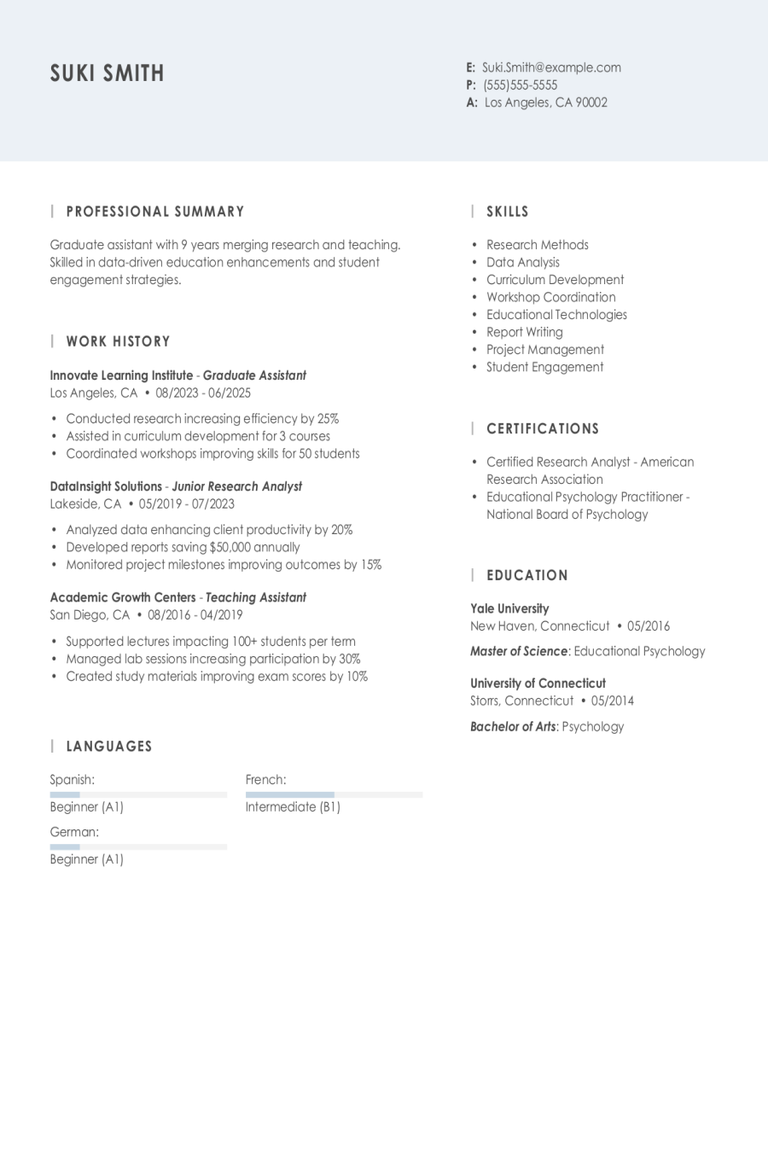
Graduate Assistant Resume Examples & Templates for 2025
Discover how graduate assistants can effectively showcase their teaching and research skills with our resume examples. Learn how to highlight your academic experience and multitasking abilities to stand out in

High School Graduate Resume Examples & Templates for 2025
Explore high school graduate resume examples that show off teamwork, problem-solving skills, and part-time job experience. Learn to highlight your school projects and volunteer work to stand out to future
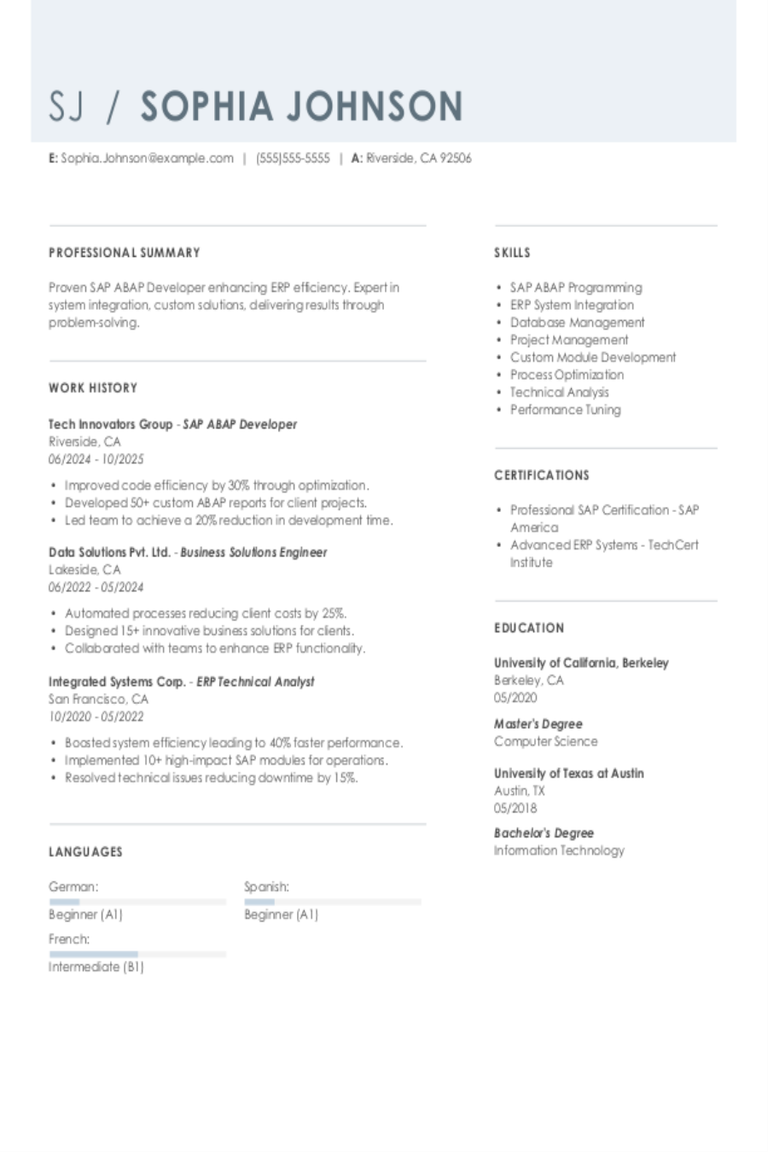
SAP ABAP Developer Resume Examples & Templates for 2025
Explore SAP ABAP developer resume examples and tips to learn how to spotlight your skills in coding, debugging, and system enhancements to stand out to hiring managers.Build my resumeImport existing
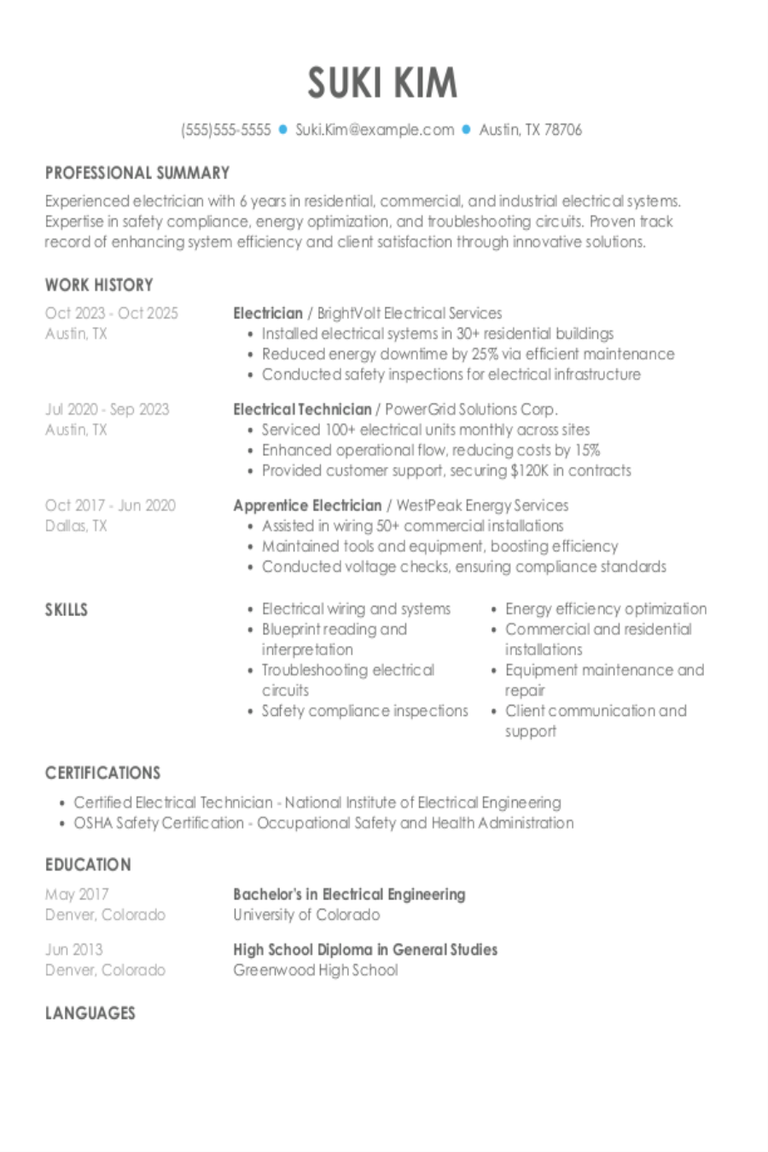
Electrician Resume Examples & Templates for 2025
Explore electrician resume examples to learn how to spotlight your wiring, troubleshooting, and safety skills. See how to emphasize your knowledge of electrical codes and highlight your experience across various
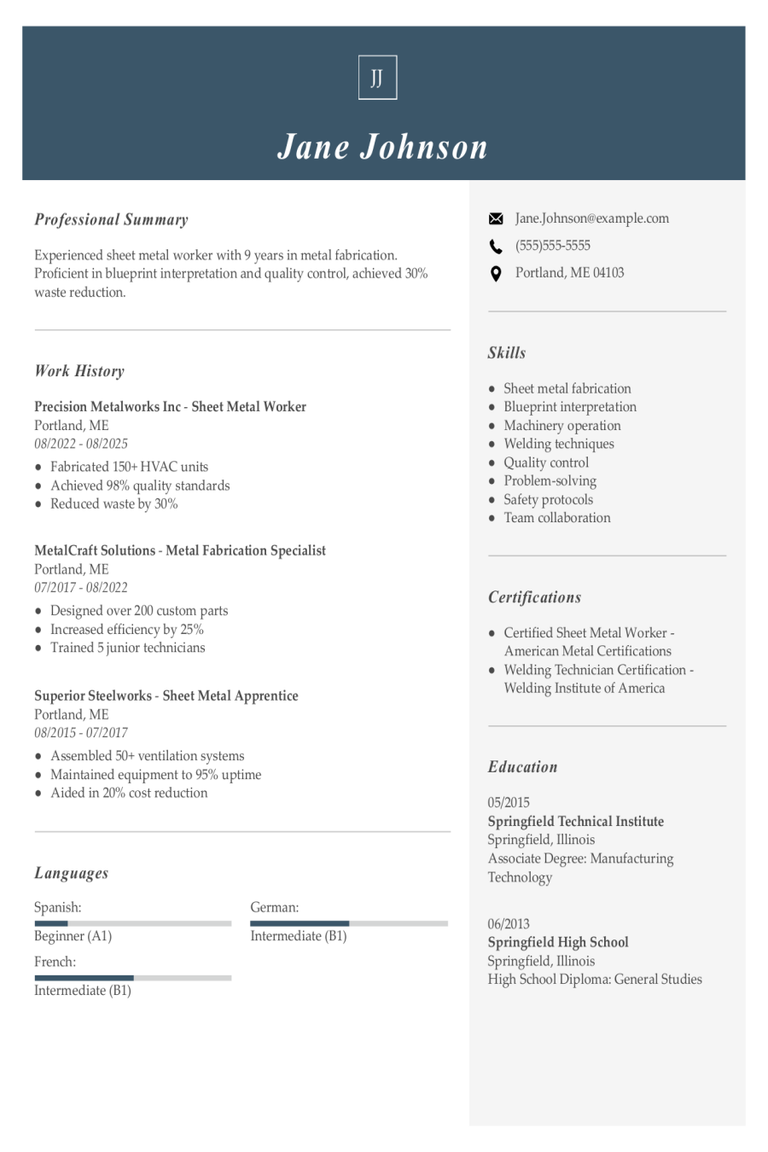
Sheet Metal Worker Resume Examples & Templates for 2025
Browse sheet metal worker resume examples and tips to learn how to highlight your hands-on experience and problem-solving abilities to stand out to recruiters and hiring managers.Build my resumeImport existing
